Pontsticill is a village situated on the edge of the historic county of Breconshire, within the valley of the Taf Fechan on the southern edge of the Brecon Beacons National Park. The village is closely associated with the Brecon Mountain Railway, which runs along the former Brecon and Merthyr Railway line. Immediately to the north of the village is the Pontsticill Reservoir which was completed in 1927. The men of the village who fell during both World Wars are commemorated on the Pontsticill War Memorial, in the form of a stone tablet, which is situated on the wall of the Memorial Hall, Vaynor Road, Pontsticill, and commemorates the nine men who fell during World War 1 and two who fell during World War 2. I have taken the opportunity to add the details of several local men who are not named on the memorial.
The Great War, 1914-1918
Harold Budge, Private, 63665, Welsh Regiment. Harold was born at 15, Templar Street, Dover in 1899, the son of Joseph Budge and Sarah Jane Budge (nee Saunders). His father was a Navy Missionary and the family had moved to 16, Tudor Avenue, Hirwaun by 1911, then prior to the war had moved to the Mission Hut, Pontsticill. Harold enlisted at Merthyr into the Training Reserve and after completing his training was posted to France, joining the 17th Battalion, Welsh Regiment, which was attached to 119 Brigade, 40th (Bantam) Division. The Division had fought during the Battle of the Ancre, in the latter stages of the Somme offensive, before remaining in the sector over the winter. In March 1917 the Germans withdrew to their shortened line, called the Hindenburg Line, and the 40th Division was among the units which followed the withdrawal. Later in the year the Division took part in the Battle of Cambrai and launched an attack on Bourlon Wood on 23 November 1917. The attack was carried out by 119 Brigade, led by the 12th SWB and 19th RWF. The 17th Welsh was in support for the initial assault, but was soon ordered to advance, to support the two attacking battalions. Heavy fighting raged within the wood over the coming days, with the 18th Welsh also being thrown forwards into the fight, and the Division suffered terribly. On 9 February 1918 the British reorganised its divisions and each brigade lost an infantry battalion, so the 17th Welsh was disbanded, and its men dispersed amongst other units. Harold was posted to Drake Battalion, which was attached to the 63rd (Royal Naval) Division. The Division was in the Cambrai sector, near to the 40th Division, when Harold transferred units. It was among the Divisions hit hard following the launching of the German Spring offensive of 21 March 1918 and saw heavy fighting as the line was pushed back from its positions at Ribecourt past Bapaume across the old Somme battlefields, before the line was held near Mesnil and the 63rd Division entrenched there. Drake Battalion was holding the line at Mesnil on 26 May when the Germans opened a fearsome trench mortar barrage upon its positions. Harold was seriously wounded during the bombardment and was evacuated to the 3rd Canadian Stationary Hospital at Doullens, where he died of his wounds on the following day, 27 May 1918. The 19-year-old was buried in Doullens Communal Cemetery Extension No.2, France.
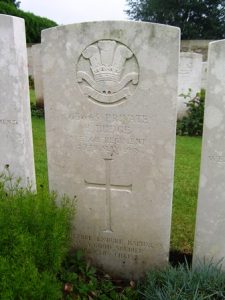
Gwilym Thomas Evans, Private, 29189, South Wales Borderers. Gwilym was the son of William Thomas and Sarah Ann Evans, of The Butcher’s Arms, Pontsticill. He enlisted at Cefn Coed into the South Wales Borderers and after completing his training was posted to France, joining the 6th Battalion, South Borderers, which was the Pioneer Battalion to the 25th Division. The Division had landed in France on 26 September 1915, and was posted to the Vimy area, where it defended Vimy Ridge against a German attack in May 1916. The division then moved to the Warloy area and attacked on 3 July near Thiepval. It fought throughout the Battle of the Somme, and then moved to Ploegsteert, where it held the line for the months leading up the Battle of Messines in June 1917. After fighting at Messines, the Division moved north, and fought at Pilckem, before moving south again, where it took up positions around Bullecourt in reserve. Here the Division was used to reinforce the badly depleted British units that were hit in the area by the German Spring Offensive. The 6th SWB had been at Favreuil Wood for most of March, working on the defences at Beaumetz and were still there when the Germans launched their offensive on 21 March 1918.The battalion was ordered to advance and help man the army line on the Bapaume to Vraucourt Road. The men got lost in the mist, travelling in unfamiliar country and settled down for the night before finding their objective the following day and began to dig in. Units of the 41st Division relieved the 6th SWB that afternoon and the men withdrew to work on the defensive line again. The battalion came under artillery fire at dawn on 23 March 1918 before being ordered forward again. Gwilym was killed in action during the move forward that morning. The 20-year-old has no known grave and is commemorated on the Arras Memorial, France.

Thomas Russell Evans, Private, 3263, Welsh Guards. Thomas was born at Vaynor in 1885, the son of Thomas Evans and Margaret Jane Evans. He married Lucy Mary Price at Merthyr in 1907 and the couple set up home at 3, Alma Street, Merthyr where their four children were born. Thomas worked as a Brewery Clerk at Merthyr prior to the war. He enlisted at Merthyr into the Welsh Guards and was posted to France in the spring of 1917, joining the 1st Battalion, Welsh Guards, which was attached to the 3rd Guards Brigade, Guards Division. The Division had seen heavy fighting during the Somme offensive, especially during its actions at the Battle of Flers-Courcelette, and then at the Battle of Morval, capturing Lesboeufs Village. The division remained here for the winter, and in March 1917 took part in the advance caused by the German Retreat to the Hindenburg Line. Later that year it moved north to Ypres and fought at the Battle of the Pilckem Ridge, the opening phase of the Passchendaele offensive, seizing the ground up to the Steenbeek. The Welsh Guards then moved back behind the lines to Proven to rest before moving back into the front line near Langemarck on 31 August 1917. Thomas was killed by German artillery fire whilst in the line here on 3 September 1917. The 32-year-old is buried in Canada Farm Cemetery, Belgium.
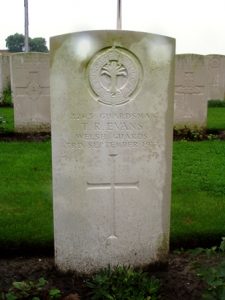
Richard James Hogarth, Private, 13930, South Wales Borderers. Richard was born in Blackpool on 1 June 1893, the son of Thomas Hogarth and Mary Ann Hogarth (nee Owens). The family was residing at 2, Tyllwyd Terrace, Pentwyn by 1911 and his mother had died four years earlier. Richard enlisted together with William Jenkins (below) into the 5th Battalion, South Wales Borderers at Cefn soon after the outbreak of war. The battalion formed at Brecon in September 1914, moving to Park House Camp, near Tidworth to join 58 Brigade, 19th (Western) Division. On 10 January 1915 the battalion became the Divisional Pioneers. Richard embarked for France with the battalion on 17 July 1915 and the entire 19th Division then moved to the Nursery Sector at Calonne for trench initiation alongside the Dehra Dun Brigade. The infantry battalions of the division then began carrying out the usual routines of rotating in the trenches: four days in the front line; four in support; and four in reserve, interspersed with training regimes and carrying out working parties and trench raids. Just south, the British launched a great offensive around the town of Loos on 25 September 1915, and the 19th Division was ordered to attack from its positions at the same time, to attempt to draw enemy attention away from the main battle area. The attacking battalions of the 19th Division were in place by 04.00, and then at 05.50 the men climbed out of their trenches to launch their assault, behind a gas and smoke screen. The assault was a disaster, and heavy casualties were suffered by the 19th Division for no gain. During the spring of 1916 the Division moved to the Somme and took part in the opening assault of 1 July 1916, capturing the villages of Ovillers and La Boiselle. The Division saw further action during the latter stages of the Somme offensive, before wintering on the Somme and in February followed the German withdrawal to the Hindenburg Line. During the middle of March 1917, the Division was relieved from the line and began to move north, taking over positions in the Ypres Salient, and on 7 June took part in the assault on Messines Ridge, which was famously preceded by the blowing of a series of 19 huge underground mines. The 19th Division saw heavy fighting during the battle, then enjoyed a short spell in reserve before moving back into the line on 11 September, taking over a section of trenches running from the Ypres-Comines Canal to Belgian Wood. On 20 September the Division took part in a costly assault past Hollebeke Chateau, to Hessian Wood. The Division wintered in the Cambrai sector, following the closure of the Battle of Cambrai, and was holding a section of the line in the Flesquières Salient. On 21 March 1918 the Germans launched the first of three offensives on to the section of the front running from Flesquières to St. Quentin, and the 19th Division was thrown into desperate fighting as it was pushed back over the coming days. The battered Division was then moved to the Messines sector to rest, but on 11 April became caught up in the second phase of the German offensive, which had been launched along the Lys Valley on 9 April, and again became caught up in desperate fighting. Richard was killed in action during a desperate defensive action on 10 April 1918. The 25-year-old has no known grave and is commemorated on the Tyne Cot Memorial, Belgium.
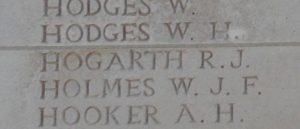
David James Horrell, Private, 245059, Loyal North Lancashire Regiment. David was the son of Alfred George Horrell and Mary Horrell (nee James), of Reservoir House, Dolygaer. His father was later the keeper of Pontsticill Reservoir. David enlisted into the army in Brecon and was posted to the 2/5th Battalion, Loyal North Lancashire Regiment, which was attached to 170 Brigade, 57th (West Lancs) Division. The Division assembled at Blackdown in Hampshire before embarking for France. The 2/5th Loyal’s landed at Le Havre on 9 February 1917 before moving to the Nursery Sector near Fleurbaix with the remainder of the Division for trench initiation. The Division then took over the La Cordonnerie sector before moving to the Le Touquet sector at Ploegsteert by 2 June. The Division suffered an intense barrage of gas shell on 6 June, but on the following day, just to its north, the Allies launched a massive assault upon Messines Ridge, preceded by the blowing of a series of deep underground mines beneath the German lines. During October the Division was relieved and by the end of the month had taken over positions near Poelcapelle, in the Ypres Salient, taking part in the latter stages of the assault on Passchendaele Ridge. The Division remained at Ypres for a month before being relieved and moving to the Wez Macquart Sector, and in February 1918, during the reorganisation of the British Army, where each brigade was reduced to three battalions, the 2/5th Loyal’s became the Pioneer Battalion to the 57th Division. The battalion then began work on the Fleurbaix and Laventie defensive line. David was wounded here on 10 March, when the battalion was hit by a German artillery barrage. He was evacuated to the hospital at Merville where he died of his wounds the following day, 11 March 1918. The 20-year-old is buried in Merville Communal Cemetery Extension, France.
William David Jenkins, Private, 13931, South Wales Borderers. William was the son of William Jenkins and Hannah Jenkins (nee Williams), of Vaynor. His father died when he was an infant and his mother married Richard Lloyd. William was raised by them at 1, Croft Cottages, Pontsticill. He enlisted into the 5th Battalion, South Wales Borderers together with Richard Hogarth (above) at Cefn soon after the outbreak of war. The battalion formed at Brecon in September 1914, moving to Park House Camp, near Tidworth to join 58 Brigade, 19th (Western) Division. On 10 January 1915 the battalion became the Divisional Pioneers. Richard embarked for France with the battalion on 17 July 1915 and the entire 19th Division then moved to the Nursery Sector at Calonne for trench initiation alongside the Dehra Dun Brigade. The infantry battalions of the division then began carrying out the usual routines of rotating in the trenches: four days in the front line; four in support; and four in reserve, interspersed with training regimes and carrying out working parties and trench raids. Just south, the British launched a great offensive around the town of Loos on 25 September 1915, and the 19th Division was ordered to attack from its positions at the same time, to attempt to draw enemy attention away from the main battle area. The attacking battalions of the 19th Division were in place by 04.00, and then at 05.50 the men climbed out of their trenches to launch their assault, behind a gas and smoke screen. The assault was a disaster, and heavy casualties were suffered by the 19th Division for no gain. During the spring of 1916 the Division moved to the Somme and took part in the opening assault of 1 July 1916, capturing the villages of Ovillers and La Boiselle. The men of the 5th SWB toiled hard during the coming days, providing carrying and working parties, before moving to Baizieux Wood for a well-deserved rest. The battalion moved to Becourt Wood on 20 July to begin work around Fricourt before moving through the desolated Mametz Wood to begin work near Bazentin. William was killed in action here on 24 July 1916. The 21-year-old has no known grave and is commemorated on the Thiepval Memorial, France.
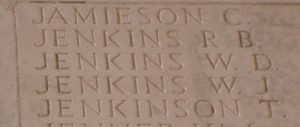
B. Jones. This man cannot presently be identified.
George Alexander Pocock, Private, 1390, Monmouthshire Regiment. George was the son of George Henry Pocock and Queenie Alice Pocock, of Mountain House, Pontsticill. He enlisted into the 3rd Battalion, Monmouthshire Regiment as a boy soldier. The battalion mobilised at Abergavenny on 4 August 1914 attached to the Welsh Border Brigade, Welsh Division, before moving to Pembroke Dock. A week later the Division moved to Oswestry, before entraining for Northampton. In February 1915 the 3rd Monmouth’s left the Welsh Division and landed in France on 14 February 1915, before entraining for Steenvoorde. The battalion was inspected by Major General Sir Herbert Plumer on 23 February then the men attended several demonstrations and classes before moving to billets at St. Jans Cappel on 28 February. On 1 March the CO, with 8 officers and 16 NCOs proceeded to the trenches for 24 hours instruction before the men entered the trenches for the first time two days later. On 3 March the 3rd Monmouth’s joined 83 Brigade, 28th Division, before moving into trenches near St Quentin Cabaret, Wulverghem. George was wounded at sometime soon after this and after being treated at a local Casualty Clearing Station was evacuated back to England for treatment at Saint Bartholomew’s Hospital in London. He died of his wounds there on 28 March 1915. The body of the 16-year-old was conveyed home and he was buried in Ebbw Vale Cemetery. George is not commemorated on the Pontsticill war memorial.
Evan Price, Private, 16055, Royal Welsh Fusiliers. Evan was the son of James and Mary Price. He married Ruth Elizabeth Spacey on 3 November 1908 and the couple resided at 1, Tynewydd Cottages, Pontsticill, where their four children were born. Evan enlisted into the Royal Welsh Fusiliers soon after the outbreak of war and was posted to the 10th Battalion, Royal Welsh Fusiliers, which was at Codford St. Mary attached to 76 Brigade, 25th Division. The 10th RWF landed in France on 27 September 1915, and two weeks later 76 Brigade became transferred to the 3rd Division at St. Eloi, near Ypres. The Division was out of the line resting when the Germans launched a period of intense fighting, known as the Actions of the Bluff, in February 1916. The Bluff was a man-made feature, created out of spoil dug out during the creation of the Ypres to Comines Canal, and afforded the high ground over the battlefield near St. Eloi. On the morning of 14 February 1916, the troops holding the Bluff were in the process of being relieved when the Germans opened an artillery barrage on top of their positions. The survivors sheltered in a tunnel during the bombardment, but the Germans then blew three underground mines, collapsing the tunnel, before launching an infantry assault upon the stunned British defenders who survived. The British counterattacked but failed to retake the lost trenches. It was then decided to send in troops who knew the ground, so 76 Brigade was ordered forward that night to prepare to launch a counterattack. Conditions were terrible, the ground being smashed up by artillery, making the terrain swamp-like and there was no cover for the men. Evan was killed during the build up to the attack, on 19 February 1916. The 26-year-old has no known grave and is commemorated on the Ypres (Menin Gate) Memorial, Belgium. Evan is not commemorated on the Pontsticill war memorial.

Albert Woodyatt, Private, 3274, Welsh Guards. Albert was the son of Edward and Annie Woodyatt, of 1, Bryn Terrace, Pontsticill. He enlisted into the Welsh Guards and after completing his training was posted to France, joining the 1st Battalion, Welsh Guards, which was attached to 3 Guards Brigade, Guards Division. The Division saw its first major action during the Battle of Loos, which began on 25 September 1915, remaining in the area during the coming months, where they also fought in the subsequent Action of Hohenzollern Redoubt. In July 1916 the Division moved to the Somme, where it fought at the Battle of Flers-Courcelette, and then at the Battle of Morval, capturing Lesboeufs Village. The division remained here for the winter, and in March 1917 took part in the advance caused by the German Retreat to the Hindenburg Line. Later that year it moved north to Ypres and fought at the Battle of the Pilckem Ridge, the opening phase of the Passchendaele offensive. The Guards Division saw further fighting at Ypres, during the later stages of the offensive, before being moved south, taking part in the Battle of Cambrai and by the end of November was in the thick of the action following the launching of the German counterattack on 30 November. Albert was badly wounded during the ferocious fighting which followed and was treated at a Casualty Clearing Station near Cambrai before eventually being evacuated back to England and was hospitalised in the Red Cross Hospital at Winchester. He died of his wounds there on 24 December 1917. The body of the 19-year-old was brought home and he was buried with full military honours in St. Gwendoline’s Churchyard, Vaynor, alongside his elder brother, Charles.
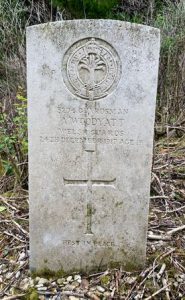
Charles Woodyatt, Sergeant, 487, South Wales Borderers. Charles was the son of Edward and Annie Woodyatt, of 1, Bryn Terrace, Pontsticill. He married Hannah Mary Thomas in 1908 and the couple resided at Mountain House, Pontsticill, where their four children were born. Charles worked for the Brecon and Merthyr Railway Co. prior to the war and was a long serving member of the Brecknockshire Battalion, South Wales Borderers. The battalion was mobilised at Brecon on 4 August 1914 and moved to Pembroke Dock attached to the South Wales Brigade, Welsh Division. The regiment sailed for the Middle East on 29 October, but Charles remained on home service at Milford Haven, joining the newly formed 2/1st Brecknockshire Battalion. The battalion formed part of the Milford Haven Garrison and was based at Dale, utilising one of the large blockhouses for its HQ. Charles took ill during the Spring of 1915 and was after a spell in hospital was sent home to recuperate. His health continued to fail, however, and Charles died at home on 21 June 1915. The 28-year-old was buried with full military honours in St. Gwendoline’s Churchyard, Vaynor. A younger brother, Albert, died of wounds in 1917 and was buried beside him.
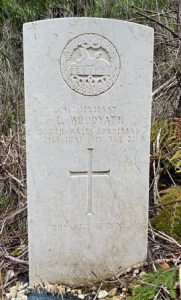
Edward James Woodyatt, Private, 200973, South Wales Borderers. Edward was the son of Edward and Annie Woodyatt, of 1, Bryn Terrace, Pontsticill. He was, together with his brother, Charles, a long serving member of the Brecknockshire Battalion, South Wales Borderers. The battalion was mobilised at Brecon on 4 August 1914 and moved to Pembroke Dock attached to the South Wales Brigade, Welsh Division. The regiment sailed for the Middle East on 29 October, but Edward remained on home service at Milford Haven for a while before returning to Brecon to join the newly formed 3/1st Brecknockshire Battalion. Following the death of his brother Charles in 1915, Edward married his widow, Hannah Mary, and the couple had a son together. Unfortunately, Edward suffered from ill health as well and was hospitalised at the 3rd Western General Hospital at Cardiff on 24 September 1917. He was discharged from the army two weeks later and returned home to his wife, son and stepchildren. Sadly, Edward’s health continued to wane, and he died at home on 27 November 1918, aged 33. Nothing further is known of Edward as he is not commemorated by the CWGC. He is not commemorated on the Pontsticill War Memorial.
World War Two, 1939-1945
Trevor Glyn Price, Private, S/97605, Royal Army Service Corps. Trevor was the son of William Henry Lloyd Price and Margaret Ann Price (nee Williams), of Ffynon Rosser Farm, Vaynor. He enlisted into the Royal Army Service Corps prior to war and was posted to the 1st Base Supply Depot, in France soon after the outbreak of war. Following the launching of the German Blitzkrieg, Trevor’s unit was forced to withdraw to the French coast for evacuation. The thousands of troops who had made it to Dunkirk had already been evacuated by 6 June, whilst more had been evacuated from Boulogne, Calais, and Le Havre by 25 May. More Allied troops had managed to reach ports in other parts of France, stretching from Cherbourg down to Bayonne, so the British organised Operation Aerial, to evacuate Allied forces and civilians from western France. Alfred had managed to reach St. Nazaire with most of his unit. On 17 June 1940, the requisitioned RMS Lancastria steamed into the Loire Estuary and anchored in the Charpentier Sounds. By the afternoon Lancastria had taken aboard a huge number of evacuees, far greater than she was built to carry, with estimates running from 4,000 to 9,000 people. The Germans had already begun attacking shipping in the area, and at 15.50 Lancastria was attacked by Junkers-88 bombers and sank in less than 20 minutes, with an estimated 6,500 lives being lost. Trevor was 21 years old when he died because of the sinking of the Lancastria that day. His body was later recovered from the sea, and he was buried in Noirmoutier-En-L’ile (L’herbaudiere) Communal Cemetery, France.
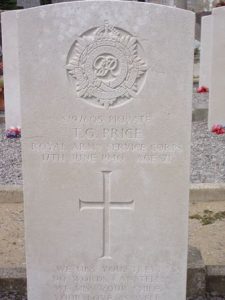
James Jeffery Smith, Gunner, 1602802, Royal Artillery. James was the son of John Smith and Hettie Smith (nee Phillips), of Aberyscir Cottage, Aberyscir. He married Hilda Jane Staley in 1939 and the couple resided at Pontsticill. He enlisted into the Royal Artillery soon after the outbreak of war and was posted to B Battery, Royal Artillery, an anti-aircraft unit based at Woolwich. The battery was among a chain of AA batteries defending the strategically important Royal Arsenal at Woolwich, which became a target of the Luftwaffe during the London Blitz. James was probably wounded during an air raid on 14 November 1940, and was taken to the Royal Herbert Hospital, Shooters Hill Road, London. He died of his wounds there on 17 November 1940. The body of the 23-year-old was brought back home, and he was buried in St. Dyfrig’s Churchyard, Gwenddwr. James is not commemorated on the Pontsticill war memorial.
Cyril John Thomas, Sergeant, 1871702, Royal Engineers. Cyril was the son of John Thomas and Mary Ellen Thomas, of Pontsticill. He married Gwladys Megan Williams, of Pontsticill, in 1941. Cyril enlisted into the Royal Engineers and was posted to the 543rd Electrical and Mechanical Company, Royal Engineers. Cyril probably served in North Africa with the company, the following the surrender of the Afrika Korps, moved to mainland Italy with his unit following the invasion of Italy on 3 September 1943. Cyril died in Italy on 28 July 1944. The 30-year-old is buried in Caserta War Cemetery, Italy.